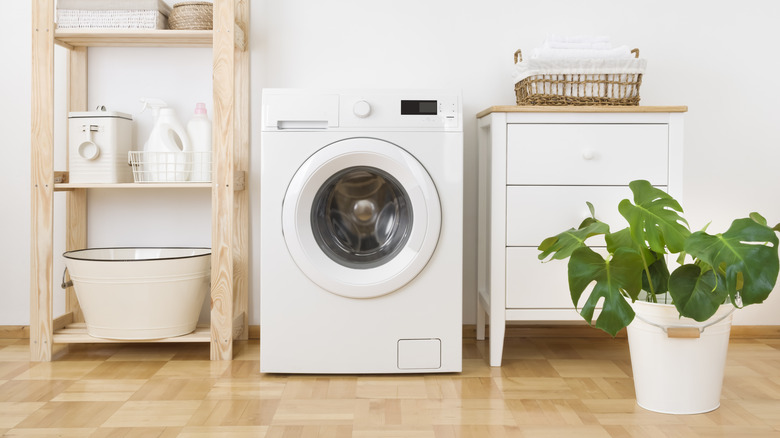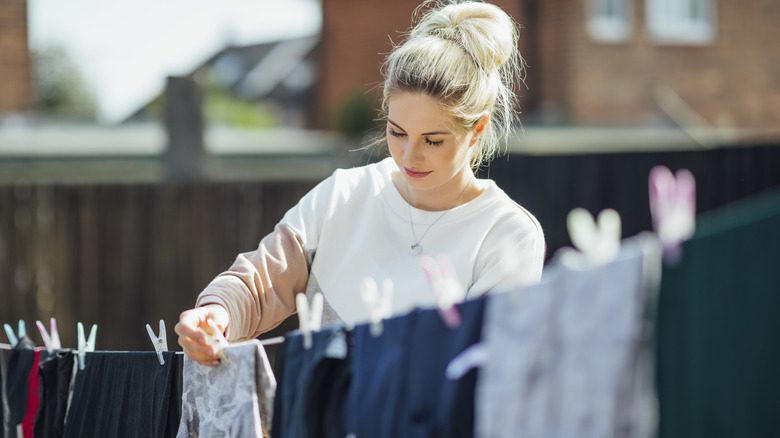Simple Sustainability Tips For A More Eco-Friendly Laundry Day
Doing laundry is a necessary chore that many people dread. Unfortunately, it's not just people who hate laundry — the environment does, too. When you clean your clothes and linens in the standard way, you're likely causing harm to the earth. Adopting a more eco-friendly laundry routine and using sustainable equipment and detergents can help you reduce your impact on laundry day, so it's well worth making some adjustments.
Washing machines are a big contributor to plastic pollution. A 2016 study published by Marine Pollution Bulletin estimates that a 6 kilogram-load of acrylic fabrics could release as many as 700,000 microplastic fibers into wastewater. This could end up in rivers and oceans and negatively impact aquatic life. Additionally, washers use up many gallons of water, while dryers need quite a bit of energy to run. Therefore, these appliances increase our energy usage and waste resources. Detergents can also release harmful chemicals into the water that will need to be treated later on. By making some smart changes when washing clothes and linens, you can reduce your carbon footprint and do your part to save the planet.
Change your laundry habits
So how should you approach laundry day to minimize your impact on the environment? The main thing that you can do is become a bit more conservative with your usage of water and detergent. Remember that doing a few large loads of laundry is better than doing many smaller loads, as they waste water and energy. Aim to start doing more laundry at once, but less often. Using less detergent for each load can also be beneficial and will reduce the amount of chemicals and microfibers that are released into the environment.
You may also want to start using cold water when washing your laundry, since this will also lead to your load releasing fewer microplastic fibers. Sierra Club reports that 86% of a washing machine's energy is used for heating the water. A single household can eliminate 1,600 pounds of carbon monoxide emissions annually by making the switch to cold water instead.
To minimize the impact of drying your clothes, use a clothesline instead of the appliance. Air-drying your clothes can decrease your household's carbon footprint by 2,400 pounds annually. Many house fires are the result of dryer issues each year as well, so hanging your clothes on the line instead is also a safer choice.
Invest in new equipment and eco-friendly products
Aside from changing your daily laundry habits, you might also want to invest in new equipment. Front-loading washing machines generally use much less energy and water compared to top-loading types. According to the Environmental Science & Technology Journal, they also release seven times fewer microfibers. To find a front-loading washing machine that's eco-friendly, look for one that is Energy Star-certified.
Switching to eco-friendly detergents and laundry products is also worthwhile. Eco-friendly detergents serve as a good alternative and are often biodegradable and made from plant-based ingredients. They also tend to be gentler on the skin and safer for the respiratory system. Further, there are also items such as laundry detergent sheets that come in cardboard packaging instead of bulky plastic bottles, thereby reducing the amount of waste that goes to landfills as well. You may also want to switch to eco-friendly fabric softeners, dryer sheets, and other laundry products. Opting for natural alternatives like wool dryer balls, vinegar, baking soda, or other natural solutions can help you keep your fabrics soft without relying on the harmful chemicals that often appear in popular brand products.


